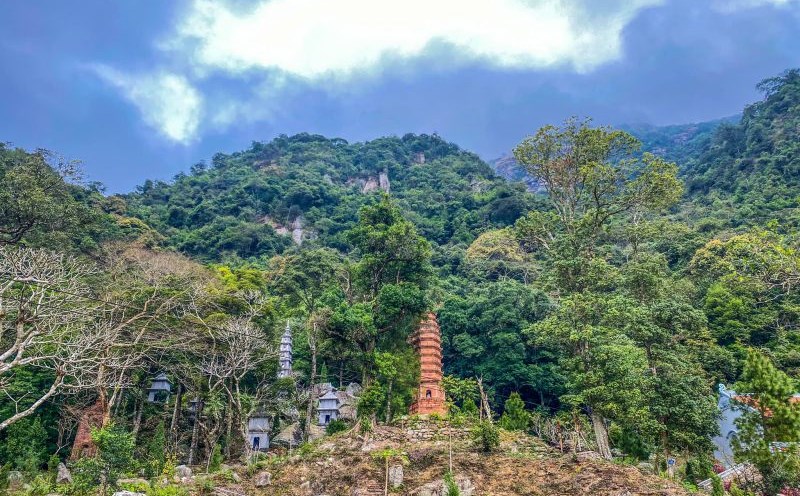Ancient temple on the land of the Forbidden City
Since ancient times, West Lake has been a famous scenic spot of the capital Thang Long, often mentioned in historical documents and poems. Previously, the area where Kim Lien Pagoda is located was called Hanh Cung mound or Cung mound. During the reign of King Ly Thanh Tong (1054 - 1072), Quan Ngu (fish watching) palace was built here. During the reign of King Ly Than Tong (1128 - 1138), Princess Tu Hoa asked to open a mulberry farm, raise silkworms with the villagers, then changed the name to Tam Tang farm and built Tu Hoa palace on this land.
During the Tran Dynasty, Tam Tang Camp was changed to Tich Ma Camp, then changed to Tich Ma Ward. According to the book "Tay Ho Chi" it is recorded that, "At the end of the Tran Dynasty, people in the hamlet built Dong Long Pagoda on the old foundation of Tu Hoa Palace of the Ly Dynasty. It still existed during the Le Dynasty". During the Le Dynasty, Tich Ma Ward was changed to Nghi Tam Ward, and from this period Dong Long Pagoda was renamed Dai Bi Pagoda.
According to ancient documents, Kim Lien Pagoda was built at the end of the Tran Dynasty, however, to date, there are no traces left from the Tran Dynasty. The traces and historical documents remaining at the pagoda show that the earliest date of Kim Lien Pagoda is the stele "Dai Bi Tu Bi Ky" placed on the left side of the Tam Quan Pagoda, built under the reign of King Le Nhan Tong, in the first year of Thai Hoa (1443).
Evaluating the outstanding architectural value of this ancient temple, educator Hoang Dao Thuy wrote about Kim Lien Pagoda, “Coming to Nghi Tam, there is an ancient and beautiful pagoda. Looking down from the dike, the pagoda has a faint appearance of a palace. It is not built in a stilt-shaped style like other pagodas, but instead has an inner and outer style, the outer style has a roof with a curved edge. The beams and columns are also made in a very special and sophisticated way. It is clearly a forbidden palace style. The gate is also different from other pagoda gates, this is Kim Lien Pagoda. It can be said that Kim Lien is the most beautiful ancient pagoda in the West Lake area.”

Unique architecture in the capital
As a large pagoda in Thang Long, over the past 5 centuries, Kim Lien Pagoda has been restored many times in different stages. In 1638, the Tam Quan and Tien Duong buildings were restored and repaired, two more Thieu Huong and Thuong Dien buildings were built, 2 more Ho Phap statues, 8 Kim Cuong statues and 3 Saint statues were made. In the 2nd year of Vinh Huu (1736), under the reign of King Le Y Tong, the people of Nghi Tam ward donated to restore the pagoda. In the 10th year of Canh Hung (1749), under the reign of King Le Hien Tong, Pho Quang tower was built to worship Venerable Quang Giac.
In the 32nd year of Canh Hung (1771), Lord Trinh Sam brought wood from Bao Lam Pagoda to restore Dai Bi Pagoda and changed its name to Kim Lien. According to the stele erected in the 4th year of Quang Trung (1792), the pagoda was severely damaged, "the people of the whole ward repaired the pagoda and built an additional front hall, spending a lot of money", in addition, information was recorded on the upper beams of the Lower and Upper Pagodas.
During the period from the 19th century onwards, Kim Lien Pagoda was renovated many times in the years: 1867, 1929, 1942, 1953, 1954. Especially from 1980 to 2000, the pagoda renovated the main hall, built the Mother House and the Ancestor House, and connected the roofs of the 3 main architectural buildings in the style of "double-hung toe-hoop".
Today, Kim Lien Pagoda still retains the basic architectural features from the Tay Son period, including many different structures. The Tam Quan gate of the pagoda was built in a special way in the form of "three mountains, four pillars", which is now the only one remaining in Kim Lien Pagoda. Passing through the Tam Quan gate is a large yard leading to the main worshiping architectural area located in the central area.
The main pagoda consists of 3 buildings, built close together in the shape of the letter "Tam", this is also a special traditional architectural style, only Kim Lien Pagoda and Tay Phuong Pagoda still retain. The architecture in front is the Lower Pagoda, next to it is the Middle Pagoda and behind is the Upper Pagoda. The Middle Pagoda in the middle is shorter than the Lower Pagoda and the Upper Pagoda, creating the feeling when looking at the architecture in the shape of the letter "Cong".
The entire three main architectural buildings of Kim Lien Pagoda were built in the “Chong diem” style, two floors and eight roofs; this architectural style has existed since the Le-Mac dynasty and is often used in bell tower architecture. On the main structures, the walls are built with bare bricks, the mortar joints are thick, creating a sense of solidity for the architecture. On the walls are carved circular windows, the inside is decorated according to the spirit of “colorless, colorless” Buddhist teachings.
Around and behind the main architectural area, there are also newly built structures. Behind the Upper Pagoda is the Ancestor's Temple. Running along the left axis of the pagoda is the Mother Temple, the Tomb Tower and the pond. Running along the right axis is the guest house area of the pagoda. The pagoda has its back to Nghi Tam village, facing West Lake.

Thang Long Buddhist Heritage
With its long-standing cultural and historical value, Kim Lien Pagoda still preserves a series of relics of great historical and cultural value. Typical of these is the system of worship statues with strong artistic value dating from the 17th to the 19th century, typically the statues of the Three Saints of the West (Amitabha, Avalokitesvara and Mahasthamaprapta), Manjushri and Samantabhadra.
In particular, the upper hall of the pagoda still preserves the statue of Princess Tu Hoa - who had great merit in helping the ancient Nghi Tam villagers to grow mulberry and raise silkworms. Next to it is a statue of Lord Trinh - who had great merit in the restoration and construction of the pagoda in history. The ancient statues in the pagoda are all depicted very vividly, bearing the special artistic features of the era.
In addition to the special system of worship statues, the pagoda also has a system of stone steles dating from the 15th to the 20th century, including a cylindrical 4-sided stele with elaborately decorated top and roof, placed in the Lower Pagoda. In the Lower Pagoda, there is also a large bell, the first two letters of the year have been chiseled off, behind which are the two words "Tam nien". Researchers believe that it may have been in the 3rd year of Quang Trung (1790) or the 3rd year of Canh Thinh (1795), due to fear of revenge from the Nguyen Dynasty, the first two letters had to be destroyed and only the two words "Tam nien" remained.
As a famous landmark of Hanoi Capital, with historical, cultural, architectural and artistic values, on April 28, 1962, the Ministry of Culture and Information (now the Ministry of Culture, Sports and Tourism) signed Decision No. 312VH-VP, recognizing Kim Lien Pagoda as a typical architectural and artistic relic.











